12-13 September 2016
During my 2012 visit to the countries of the former Yugoslavia, the country I missed seeing was Kosova. Not only did Serbia frown on anyone entering the area, but they would not recognize a passport stamp issued by what Serbians thought as Serb territory. Not that things have changed in 2016; today I travel from Macedonia and no such tensions exist south of the border. And I say “Kosova” to the contrary of maps and notables because that is how locals refer to their country.
While in Serbia in 2012, students told me they would “never go to Trieste because it was taken from Serbia” and “Kosovo is dangerous don’t go there.” Typical of Serb dictator Milošević, nothing deterred him from his mission of ethnic cleansing and claiming the territory of Kosovo, until US intervention. Just 13 years earlier my military was dropping bombs on buildings two blocks from where I slept in Belgrade.
There is a rawness and passion to Serb feelings – they hold grudges. “We have a war every 50 years,” a guide told me. Author Rebecca West tried to explain this fatalism, this expectation that another war is just over the horizon. All it would take is another “Nationalist” like Milošević or Tuđman. No wonder many wish Tito was still alive.
Four years later, I am traveling the mountainous roads and through the villages of Kosova. The clouded peaks rise continuously into the distance; crystal clear waters flow down the streams. It is beautiful yet a bit mysterious. It is Kosova yet it is much the continuation of what I have traveled for several days. Mountains and forests, villages, minarets, bazaars, people going about their daily work, restaurants, gas stations, good roads and cafes. Smokers and trash.
Today, the 12th, is another holiday, Eid Al-Adha – the Feast of the Sacrifice or “Bakr-Eid.” It is the second of two Muslim holidays celebrated worldwide, and considered the holier of the two. It honors the willingness of Abraham to sacrifice his son. The meat from a sacrificed animal is divided into three parts. The family retains one third of the share; another third is given to relatives, friends and neighbors; and the remaining third is given to the poor and needy.
For the most part, the holiday does not effect travel. My first destination a monastery in Desan to the northwest at the edges of the mountainous National Park Bjeshkët e Nemuna.
The big difference between Kosova and its neighbors? An expectancy that it could all change overnight. Nothing demonstrates that more then the presence of KFOR.
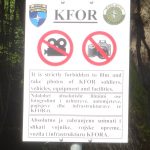 The Kosovo Force (KFOR) is a NATO peacekeeping force which is responsible for establishing a secure environment in Kosova. KFOR entered Kosovo on 12 June 1999. At the time, Kosova was facing an humanitarian crisis, with military forces from the Federal Republic of Yugoslavia and the Kosova Liberation Army in constant skirmishes. According to NATO, Serb forces had committed ethnic cleansing of Kosova Albanians and the death toll had reached historic highs. Nearly one million people had fled Kosovo as refugees. Today, KFOR focuses on building a secure environment in which all citizens, irrespective of their ethnic origins, can live in peace and, according to our guide, the nationalist can’t come in and finish what they started. (Here the word “nationalist” is relevant to who is speaking as all ethnicities have nationalist forces operating in their own interests.)
The Kosovo Force (KFOR) is a NATO peacekeeping force which is responsible for establishing a secure environment in Kosova. KFOR entered Kosovo on 12 June 1999. At the time, Kosova was facing an humanitarian crisis, with military forces from the Federal Republic of Yugoslavia and the Kosova Liberation Army in constant skirmishes. According to NATO, Serb forces had committed ethnic cleansing of Kosova Albanians and the death toll had reached historic highs. Nearly one million people had fled Kosovo as refugees. Today, KFOR focuses on building a secure environment in which all citizens, irrespective of their ethnic origins, can live in peace and, according to our guide, the nationalist can’t come in and finish what they started. (Here the word “nationalist” is relevant to who is speaking as all ethnicities have nationalist forces operating in their own interests.)
Arriving at the Dečani Monastery in Desan we are “greeted” and passports checked by the KFOR peacekeeping soldiers, represented by Sicilians in camouflage, full security with big guns velcroed to their thighs. War still existed in this region in 1999 and tensions further north are still felt. Therefore, the soldiers are here to protect Serbian monuments and monasteries. I see more police presence today than in the past two weeks combined. Dečani Monastery is in disputed territory and the fear is that Albanian forces will return to destroy it.
Not an unrealistic fear when one considers the long history of advisories wishing to destroy the monastery from Austro Hungarians in WWI to Albanian Nationalist Balli Kombëtar known as Ballists in WWII. The monastery has sheltered Albanians, Romanis, Serbs and other minorities. Italians seem to have helped to protect it over time and continue to do so in the form of the KFOR. Otherwise, it is not unreasonable to think of some group arriving to destroy everything.
That would be a international tragedy. Construction began on the monastery and church during the reign of Serbian King Stefan in 1327 and took eight years to complete. The monastery was a royal church at a time when the territory was part of the Kingdom of Serbia. Dedicated to Ascension of Our Lord, it is filled with the most awesome, well preserved frescoes imaginable. Every inch of wall and ceiling is covered with saints and allegories, kings and heroes. It is truly a “Wow!” moment. The main hall and apse is a masterpiece of Orthodoxy. The beautiful iconostasis was produced in Macedonia and overhead is a massive bronze chandelier. The dome rises 85′ above my head.
Valuable documents and printed books from the 14-15th centuries are kept at the monastery. The church is also the repository for the remains of King Stefan who died in 1331. (Stefan later took the name Dečanski from the monastery.) Dečanski’s son, Stefan Dušan, seized the Serbian throne in 1331 and had his father strangled to death shortly afterwards. Dečanski was buried in the still incomplete monastery in 1331 but his carved wooden sarcophagus wasn’t finished until 1340. Buried alongside King Stefan is his murderous son, Dušan, and his mother, Helen the Queen Consort, who had left the thrown and become a nun, probably disappointed in her grandson.
We are guided by Petar, a kindly monk who came here as a guest in 2002 and decided to spend the rest of his life at Dečani. Walking around the gardens and the wonderful church with its multi-level roof and iconic design, I can understand his decision. He tells us that during the time of Tito, the monastery was used as a tourist hotel. It would be a loss if such a fate again fell upon the 25 monks who so lovingly attend to this masterpiece.
On 2 July 2004, the monastery was declared a UNESCO World Heritage Site.
We drive further north, noting all signs are required to be bilingual – Albanian and Serbian. The Kosova ethnic majority may be Albanian but Serbs dispute the territory. The further north, the higher the tensions.
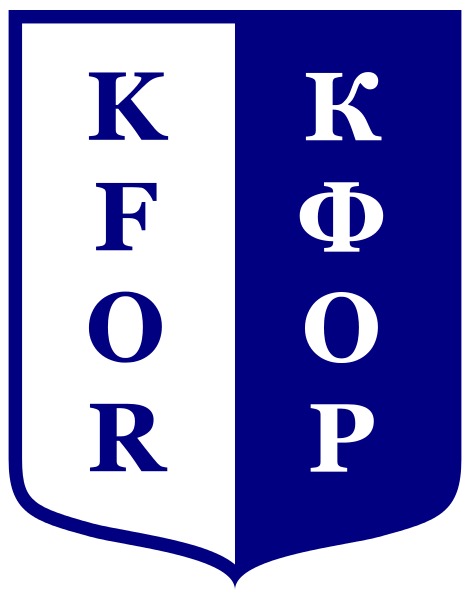 We arrive in Peja to more KFOR security and enter the Peja Patriarchate for nuns. We are guided around the church by audio speaker and watched closely by nuns. This is the Church of the Holy Apostles, built in 1331. It consists of four exquisitely frescoed chapels and a main hall. The frescoes are in good condition. Byzantine Blue is commonly used here, especially in the small St Nicholas Chapel.
We arrive in Peja to more KFOR security and enter the Peja Patriarchate for nuns. We are guided around the church by audio speaker and watched closely by nuns. This is the Church of the Holy Apostles, built in 1331. It consists of four exquisitely frescoed chapels and a main hall. The frescoes are in good condition. Byzantine Blue is commonly used here, especially in the small St Nicholas Chapel.
Our third stop is the Battlefield of Kosova, about 3 miles northwest of Prishtina. This field is important to Serbian history, tradition, and national identity. It is the tragic site of a major battle between the Christian armies led by the Serbian Prince Lazar and the Ottoman armies under the command of Sultan Murad.
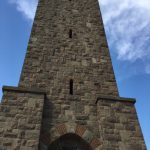 On the 15 June 1389, the army under Prince Lazar consisted of his own troops, a contingent led by another Serbian nobleman, and a contingent sent from Bosnia by its king. Prince Lazar was the ruler of Moravian Serbia and the most powerful among the Serbian regional lords of the time.
On the 15 June 1389, the army under Prince Lazar consisted of his own troops, a contingent led by another Serbian nobleman, and a contingent sent from Bosnia by its king. Prince Lazar was the ruler of Moravian Serbia and the most powerful among the Serbian regional lords of the time.
Lazar’s army numbered from 12,000 to 30,000, most were under Lazar’s command. Also present were Knights Hospitalier led by a Croatian knight and several thousand other knights. Furthermore, there were several accounts at the time which mentioned that the “Christian army” of Lazar was far greater, and that it also included contingents of other nations, although these cannot be verified. Reliable historical accounts of the battle are scarce.
Murad’s forces numbered from 27,000 to 40,000 fighters. The Ottoman army was supported by the forces of the Anatolian Turkoman.
According to records of the event, both armies were annihilated in the battle; Lazar and Murad were killed, and the remnants of their armies eventually retreated from the battlefield. (The Ottomans continued their march north capturing Balkan territories.) The battlefield, littered with so many dead, was said to be black with birds feeding on the dead. It was thus known as the “Field of the Blackbirds.”
Since 1953, a simple, square tower rises above the battlefield commemorating this horrific battle. No wonder Serbia does not want to recognize Kosova independence, thus removing this sacred ground from Serbian soil.
Closeby is a monument to the Ottoman side of the Battlefield of Kosova represented by the simple Tomb of Sultan Murad I. The tomb, in Kosova Polje, is where Murad’s internal organs were buried, and has gained a religious significance for local Muslims. A monument built by Murad I’s son at the tomb became the first example of Ottoman architecture in the “Kosovo territory.” No peacekeepers were seen here, just exuberant boys playing and practicing their English.
We did briefly stop in Prishtina but, because of the holiday, the bazaar was empty, museum closed, mosque passed by. This is the capital? The Clock Tower was nice but most cafes were empty. The most exciting stop probably was the city’s monument to Bill Clinton with its nearby Hillary store. Most likely one of those statues that will quickly be torn down if Kosova ever looses its independence from Serbia.
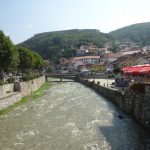 So we head to our hotel in Prizren where the life of Kosova seems to be in full-party mode. We are surrounded by three mosques X three calls to prayer X 5 times a day, but the streets and cafes are a lively mix of citizens – mostly men.
So we head to our hotel in Prizren where the life of Kosova seems to be in full-party mode. We are surrounded by three mosques X three calls to prayer X 5 times a day, but the streets and cafes are a lively mix of citizens – mostly men.
In the morning we walk this relatively compact town in a few minutes. Prizren is a city of several mosques, several minarets surround the hotel – all well heard during call to prayer. A fortress towers above town, a fast river flows through it and is crossed by lovely old stone bridges. Scattered about on corners are statues of hero soldiers killed in the recent 1998-1999 war. Churches include catholic (Mother Teresa’s father baptized here), orthodox and mosque.
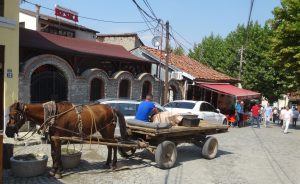 There are not a lot of sights but its fun to stroll and note the churches, lines of eager “shoppers” in front of the Red Cross offices (for meats or shoes?), shops just opening, lots of young people and many men beginning to populate cafes and corners to talk about these strange tourists. Add into the mix the jumble of electric wires at the corners, the many houses in need of repair, the horse drawn wagons in the streets, and Prizren comes off as a pleasant and manageable city.
There are not a lot of sights but its fun to stroll and note the churches, lines of eager “shoppers” in front of the Red Cross offices (for meats or shoes?), shops just opening, lots of young people and many men beginning to populate cafes and corners to talk about these strange tourists. Add into the mix the jumble of electric wires at the corners, the many houses in need of repair, the horse drawn wagons in the streets, and Prizren comes off as a pleasant and manageable city.
Sit in a cafe for awhile and you will begin to see the ethnic mix of this lively community. Turkish is the minority culture and though hardline communist dictator Hoxha criminalized religion and in 1976 declared Albania the first atheist state in the world, currently over 58% of Albanians are Muslim, mostly secular Sunni.
Kosova is one of the youngest independent countries of Europe, declaring its independence in 2008, but still subject to a territorial dispute with Serbia. Though Serbia refuses to recognize Kosova, 109 out of 193 United Nation members, led by the US, has. Which is probably why Pristhina has a full-sized statue of President Bill Clinton.
Bombings led to the withdrawal of Yugoslav forces from Kosova and the resignation of Milošević in 2000. I shudder to think if Milošević had not capitulated: the US was ready to deploy a ground force into the mountains and plains of Kosova. It was estimated an army of 500,000 would be needed to achieve success. After seeing Balkan terrain and resistance, I believe such an intervention would have been disastrous.
My 2012 lunch mates in Belgrade commented “Kosovo is lost and everyone knows it. Politicians will not act to give Kosovo independence. Serbia holds onto Kosovo though we lost it 10 years ago; but if we give up Kosovo, the Vojvodina will follow. This is unacceptable for Serbia.” Will a peaceful life continue here?
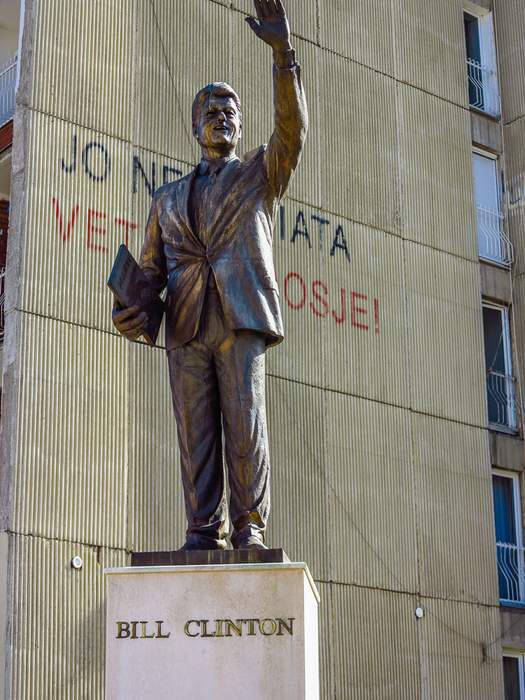 Today in 2016, it appears not a lot has changed, in spite of which side of the border I travel. This is a beautiful, rugged, resilient and ‘long-memoried’ mix of ethnicities, tribal and religious loyalities. History cannot be ignored nor rewritten in order to blind or fool future generations. The history of the Balkans, as all countries, shows deeply flawed acts perpetrated by deeply flawed people. All can profit from an expression of sincere regret and a move forward to a lasting reconciliation. The Balkans must face reality if they are not to repeat this fear of and attack on their neighbors every 50 years. I think the survival of the Dečani Monastery and that Clinton statue depends upon it.
Today in 2016, it appears not a lot has changed, in spite of which side of the border I travel. This is a beautiful, rugged, resilient and ‘long-memoried’ mix of ethnicities, tribal and religious loyalities. History cannot be ignored nor rewritten in order to blind or fool future generations. The history of the Balkans, as all countries, shows deeply flawed acts perpetrated by deeply flawed people. All can profit from an expression of sincere regret and a move forward to a lasting reconciliation. The Balkans must face reality if they are not to repeat this fear of and attack on their neighbors every 50 years. I think the survival of the Dečani Monastery and that Clinton statue depends upon it.
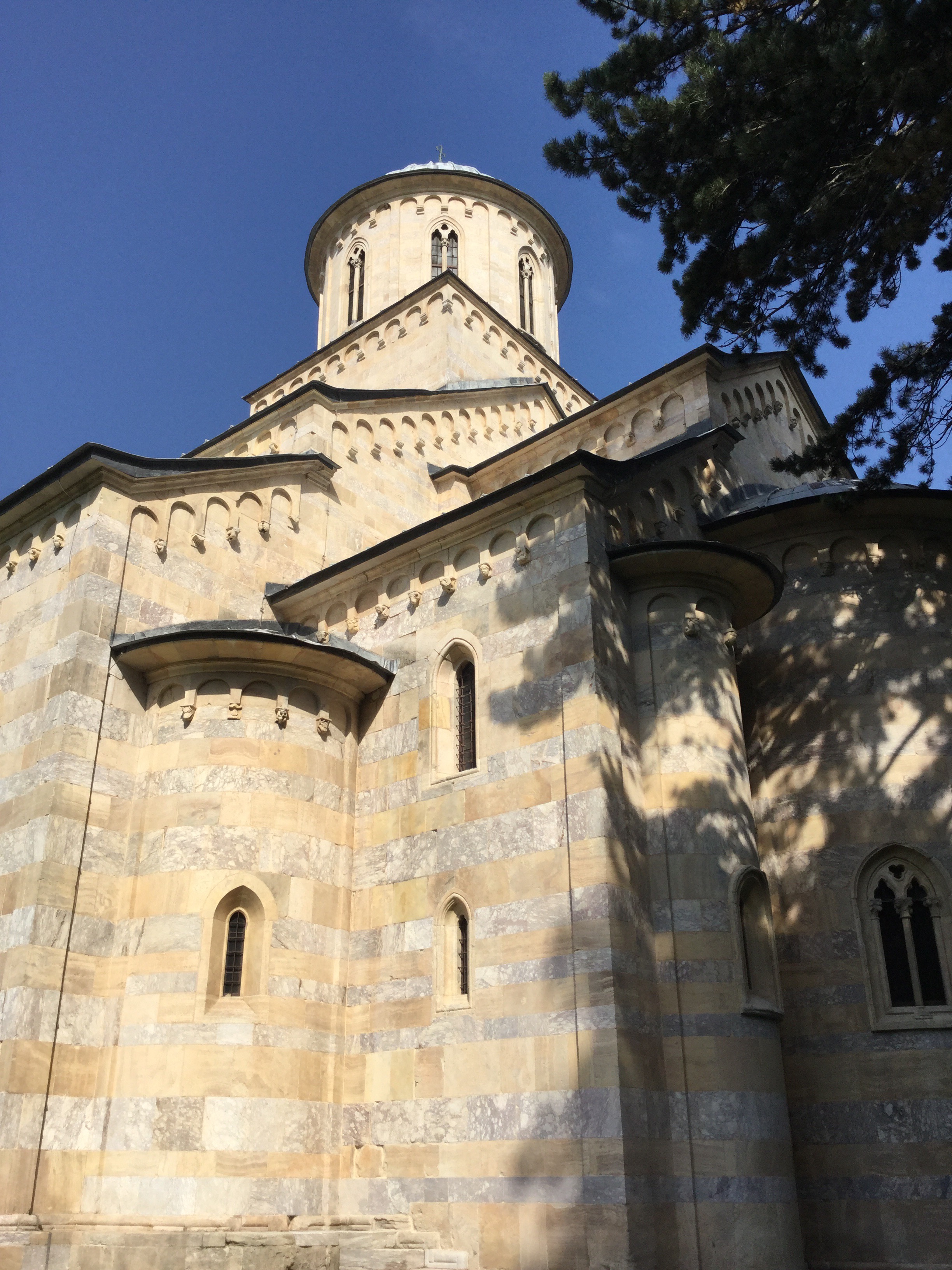

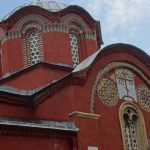
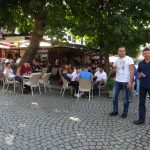
0 Comments